
A polyp in zoology is one of two forms found in the phylum Cnidaria, the other being the medusa. Polyps are roughly cylindrical in shape and elongated at the axis of the vase-shaped body. In solitary polyps, the aboral end is attached to the substrate by means of a disc-like holdfast called a pedal disc, while in colonies of polyps it is connected to other polyps, either directly or indirectly. The oral end contains the mouth, and is surrounded by a circlet of tentacles.

Anthozoa is a class of marine invertebrates which includes the sea anemones, stony corals and soft corals. Adult anthozoans are almost all attached to the seabed, while their larvae can disperse as part of the plankton. The basic unit of the adult is the polyp; this consists of a cylindrical column topped by a disc with a central mouth surrounded by tentacles. Sea anemones are mostly solitary, but the majority of corals are colonial, being formed by the budding of new polyps from an original, founding individual. Colonies are strengthened by calcium carbonate and other materials and take various massive, plate-like, bushy or leafy forms.

Antipatharians, also known as black corals or thorn corals, are an order of soft deep-water corals. These corals can be recognized by their jet-black or dark brown chitin skeletons, surrounded by the polyps. Antipatharians are a cosmopolitan order, existing at nearly every location and depth, with the sole exception of brackish waters. However, they are most frequently found on continental slopes under 50 m (164 ft) deep. A black coral reproduces both sexually and asexually throughout its lifetime. Many black corals provide housing, shelter, food, and protection for other animals.

Scleractinia, also called stony corals or hard corals, are marine animals in the phylum Cnidaria that build themselves a hard skeleton. The individual animals are known as polyps and have a cylindrical body crowned by an oral disc in which a mouth is fringed with tentacles. Although some species are solitary, most are colonial. The founding polyp settles and starts to secrete calcium carbonate to protect its soft body. Solitary corals can be as much as 25 cm (10 in) across but in colonial species the polyps are usually only a few millimetres in diameter. These polyps reproduce asexually by budding, but remain attached to each other, forming a multi-polyp colony of clones with a common skeleton, which may be up to several metres in diameter or height according to species.
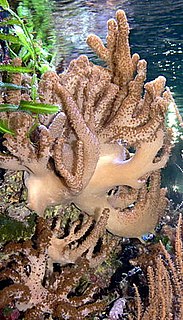
Alcyonacea, or soft corals, are an order of corals. In addition to the fleshy soft corals, the order Alcyonacea now contains all species previously known as "gorgonian corals", that produce a more or less hard skeleton, though quite different from "true" corals (Scleractinia). These can be found in suborders Holaxonia, Scleraxonia, and Stolonifera. They are sessile colonial cnidarians that are found throughout the oceans of the world, especially in the deep sea, polar waters, tropics and subtropics. Common names for subsets of this order are sea fans and sea whips; others are similar to the sea pens of related order Pennatulacea. Individual tiny polyps form colonies that are normally erect, flattened, branching, and reminiscent of a fan. Others may be whiplike, bushy, or even encrusting. A colony can be several feet high and across, but only a few inches thick. They may be brightly coloured, often purple, red, or yellow. Photosynthetic gorgonians can be successfully kept in captive aquaria.

Parazoanthus axinellae, commonly known as the yellow cluster anemone, is a zoanthid coral found on the southern Atlantic coasts of Europe and in the Mediterranean Sea. Zoanthids differ from true sea anemones, in having a different internal anatomy and in forming true colonies in which the individual animals (polyps) are connected by a common tissue, called the coenenchyme.
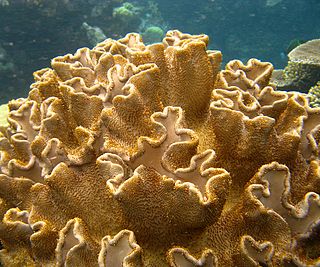
Alcyoniidae is a family of leathery or soft corals in the phylum Cnidaria.
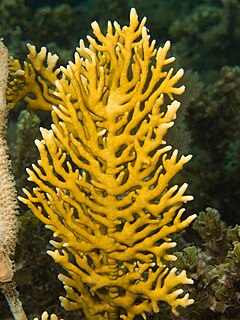
Millepora alcicornis, or sea ginger, is a species of colonial fire coral with a calcareous skeleton. It is found on shallow water coral reefs in the tropical west Atlantic Ocean. It shows a variety of different morphologies depending on its location. It feeds on plankton and derives part of its energy requirements from microalgae found within its tissues. It is an important member of the reef building community and subject to the same threats as other corals. It can cause painful stings to unwary divers.

Leptogorgia hebes, commonly known as the regal sea fan or false sea fan, is a species of soft coral in the family Gorgoniidae. It was formerly included in the genus Lophogorgia but that genus has been dismantled.

Alcyonium acaule or Mediterranean sea-finger is a species of soft coral in the family Alcyoniidae. It is found at moderate depths on shaded rocks in the Mediterranean Sea and adjoining parts of the Atlantic Ocean.
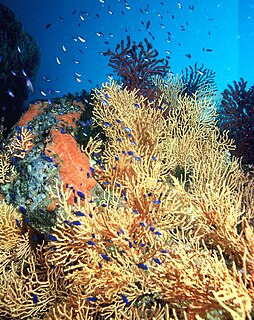
Eunicella cavolini, commonly known as the yellow gorgonian or yellow sea whip, is a species of colonial soft coral in the family Gorgoniidae. It is native to parts of the eastern Atlantic Ocean, Mediterranean Sea and Ionian Sea where it is a common species.

Alcyonium coralloides, commonly known as false coral, is a colonial species of soft coral in the family Alcyoniidae. It is native to the northeastern Atlantic Ocean and the Mediterranean Sea. In the former location it generally grows as sheets or small lobes but in the latter it is parasitic and overgrows sea fans.

Favites pentagona is a species of stony coral in the family Merulinidae, sometimes known as larger star coral. It is native to the Indo-Pacific region and its range extends from the Red Sea through the Indian Ocean to the Western Pacific Ocean. This is a common species throughout its wide range and the International Union for Conservation of Nature has rated its conservation status as being of "least concern".
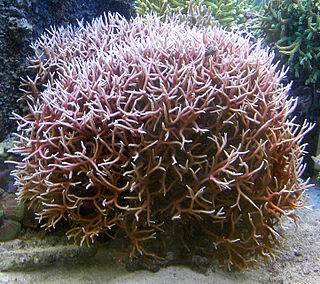
Seriatopora hystrix is a species of colonial stony coral in the family Pocilloporidae. It forms a branching clump and is commonly known as thin birdsnest coral. It grows in shallow water on fore-reef slopes or in sheltered lagoons, the type locality being the Red Sea. It is native to East Africa, the Red Sea and the western Indo-Pacific region. It is a common species and the International Union for Conservation of Nature has assessed its conservation status as being of "least concern".

Savalia savaglia, commonly known as gold coral, is a species of colonial false black coral in the family Parazoanthidae. It is native to the northeastern Atlantic Ocean and the Mediterranean Sea where it often grows in association with a gorgonian. It is extremely long-lived, with a lifespan of 2,700 years, and develops into a large tree-like colony.

Platygyra daedalea, sometimes known as the lesser valley coral, is a colonial species of stony coral in the family Merulinidae. It occurs on reefs in shallow water in the Indo-Pacific region. It is a common species and the International Union for Conservation of Nature has assessed its conservation status as being of "least concern".
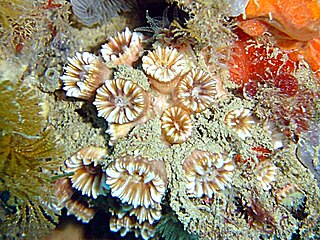
Polycyathus muellerae is a small species of coral in the family Caryophylliidae in the order Scleractinia, the stony corals. It is native to the northeastern Atlantic Ocean and the Mediterranean Sea. It is a large polyp, colonial coral and grows under overhangs and in caves as part of an assemblage of organisms suited to these poorly-lit sites.
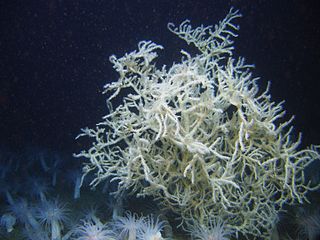
Leiopathes glaberrima is a species of black coral of the order Antipatharia found in the northern Atlantic Ocean and the Mediterranean Seas deep water habitats. A very slow-growing species, it is among the oldest living animals on the planet.
Endozoicomonas gorgoniicola is a Gram-negative and facultative anaerobic bacterium from the genus of Endozoicomonas. Individual cells are motile and rod-shaped. Bacteria in this genus are symbionts of coral. E. gorgoniicola live specifically with soft coral and were originally isolated from a species of Plexaura, an octocoral, off the coast of Bimini in the Bahamas. The presence of this bacterium in a coral microbiome is associated with coral health.

Obelia dichotoma is a broadly distributed, mainly marine but sometimes freshwater, colonial hydrozoan in the order Leptothecata that forms regular branching stems and a distinctive hydrotheca. O. dichotoma can be found in climates from the arctic to the tropics in protected waters such as marches and creeks but not near open coasts like beaches in depths up to 250m. O. dichotoma uses asexual and sexual reproduction and feeds on mainly zooplankton and fecal pellets. Obelia dichotoma has a complex relationship with the ecosystem and many economic systems.



















